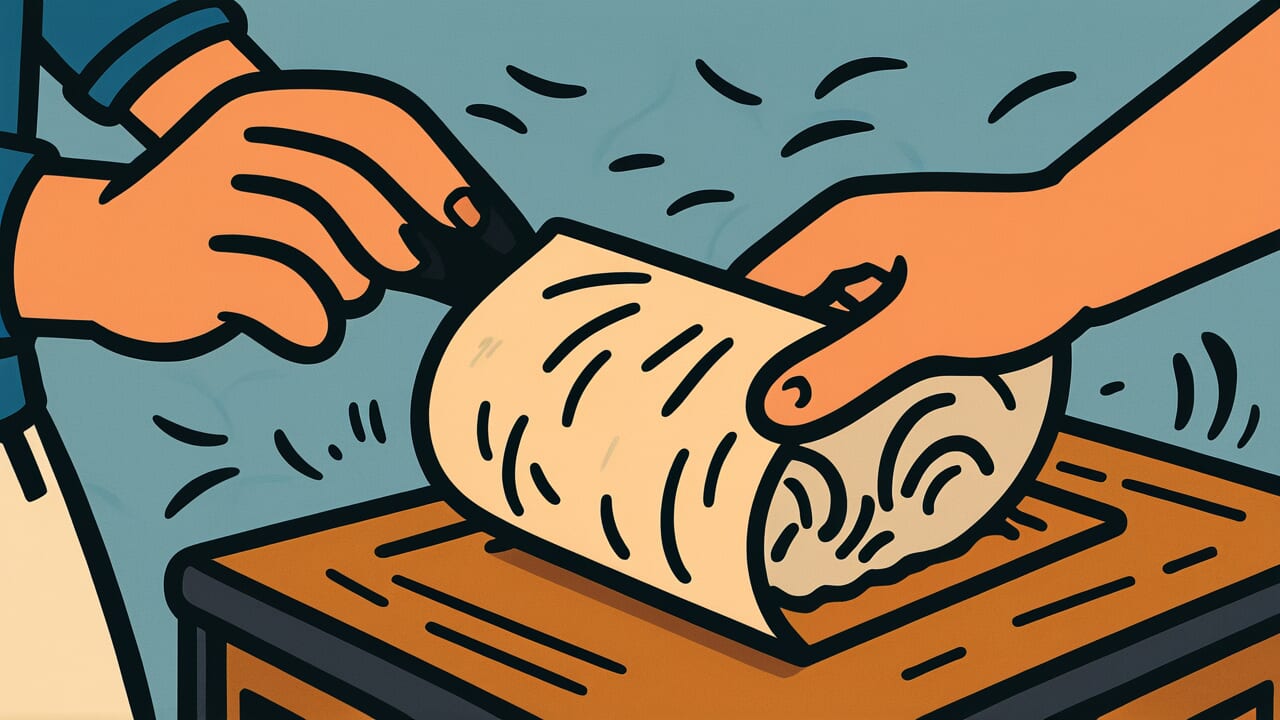How to Read “A papermaker’s nose-blowing”
Kamisuki no tebanа
Meaning of “A papermaker’s nose-blowing”
“A papermaker’s nose-blowing” is a metaphor for unreliable plans or useless behavior. It points out the foolishness of choosing an ineffective method when a proper solution is right there.
This proverb is used when someone picks an inappropriate method to solve a problem. It also applies when people fail to use the resources they have.
The image is quite comical. A papermaker blowing their nose with their hands instead of using the paper they make symbolizes missing the point completely.
Even today, you can use this saying in various situations. It fits when experts make amateur judgments in their own field. It also works when people choose inconvenient methods despite having better tools available.
This proverb warns us with humor about a human blind spot. We often overlook the best solutions right in front of us.
Origin and Etymology
No clear written records explain the origin of this proverb. However, we can make interesting observations from the words themselves.
“Kamisuki” refers to craftsmen who make Japanese paper. This traditional profession has continued since the Edo period.
These artisans dissolve plant fibers from mulberry or mitsumata in water. They then use a tool called suketa to strain and form paper. Their hands stay constantly wet during this work.
“Tehana” means blowing your nose with your hands directly. This was common among ordinary people in times before tissue paper. Today we consider it bad manners.
Now think about this situation. What does it mean for a papermaker to blow their nose with their hands?
Papermakers are surrounded by the paper they create. Yet they blow their noses with wet hands instead. This is truly backwards behavior.
This contradictory situation gave birth to the proverb’s meaning. It describes choosing inappropriate methods when good tools are available.
The sharp observation of common people watching craftsmen’s daily lives likely created this humorous saying.
Usage Examples
- Sticking to old methods after introducing a new system is like a papermaker’s nose-blowing
- Making amateur decisions when experts are available is a papermaker’s nose-blowing
Universal Wisdom
“A papermaker’s nose-blowing” reveals a universal truth about human nature. We often cannot see what is closest to us.
Sometimes we overlook solutions right in front of us. Instead, we choose roundabout methods unnecessarily.
Why does this happen? Humans tend to undervalue things they know well. For papermakers, paper is too ordinary. They make it every day, so they stop noticing its convenience.
This psychology applies deeply to our modern lives too.
This proverb also highlights “the expert’s blind spot.” Precisely because something is your specialty, you overlook basic things. You are too close to see objectively.
Our ancestors tried to teach an important lesson through this comical image. Even excellent tools or knowledge mean nothing if you cannot use them properly.
True wisdom lies in recognizing the value of what you have. It means using your resources appropriately.
This proverb has been passed down for generations for good reason. Human nature does not change with time. We always risk missing treasures at our feet.
When AI Hears This
A papermaker blowing their nose while hands are submerged in water is surprisingly rational from a fluid dynamics perspective. Nasal discharge released underwater shows completely different diffusion patterns than in air.
First, consider the difference in diffusion speed. Blowing your nose in air sends droplets several meters away. They dry and continue floating in the air.
In water, viscous resistance is about 50 times greater than air. Nasal discharge decelerates rapidly after release. Water density is about 800 times that of air, making matter sink more easily.
Underwater nose-blowing limits dispersion to just a few centimeters. The matter quickly sinks to the bottom.
The boundary layer effect is also important. Papermaking tanks are relatively calm environments. The Reynolds number stays below 1000 in laminar flow conditions.
Under these conditions, water flows in layers. Different layers barely mix. A thin boundary layer forms around where you blow your nose. Contaminants stay trapped within that layer.
The craftsman can move their hand slightly. This carries the entire boundary layer away with the water flow.
In other words, craftsmen discovered through experience how to maintain hygiene without interrupting work. They used water’s high viscosity and laminar flow characteristics.
Lessons for Today
This proverb teaches modern people “the importance of recognizing nearby value.” Wonderful solutions surround us, yet we often search far away without noticing them.
Modern society especially focuses on new things and distant places. We chase the latest tools and trendy methods. Meanwhile, we neglect reliable means already in our hands.
What truly matters is the wisdom to maximize what we already have.
Look around your workplace or home. Do you have tools you are not fully using? Are there people whose talents you have not recognized? Do you have personal strengths you have not noticed?
Pursuing distant ideals is important. But start by finding treasures at your feet.
Take time to reflect objectively on your actions. The more expert you are, the more important returning to basics becomes.
Things that seem too obvious to notice may actually be most valuable. Developing eyes to rediscover the value of familiar things is the modern wisdom this proverb teaches.



Comments